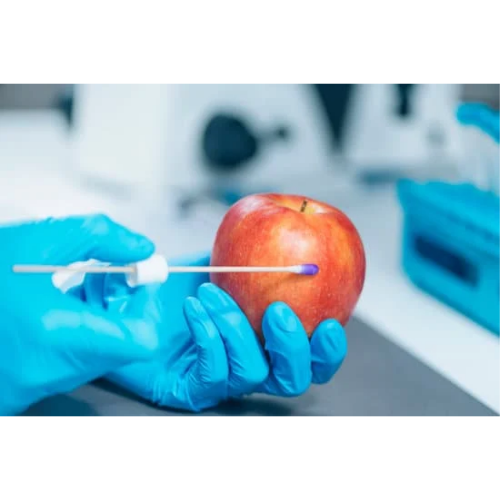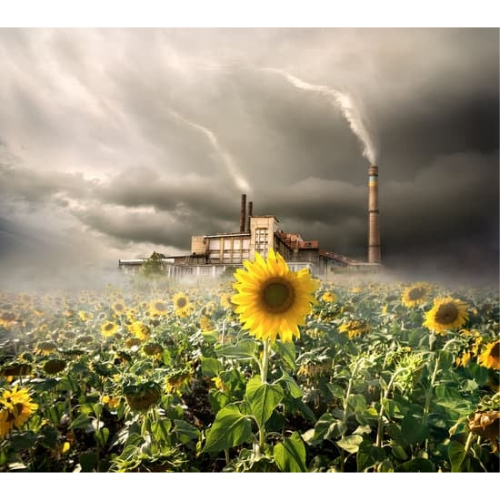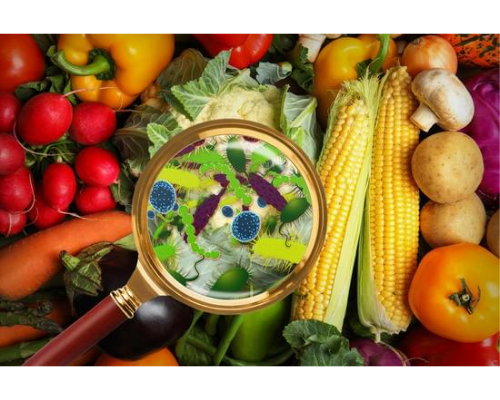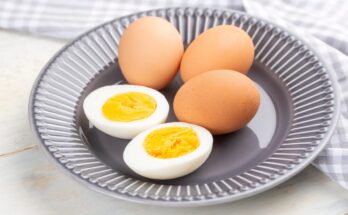Growing plants carry a typical flora of microorganisms on their surfaces and may become contaminated from outside sources. Animals likewise have a typical surface flora plus an intestinal one, give off organisms in excretions and secretions, and also become contaminated from outside sources. Plants and animals with parasitic disease, of course, carry the pathogen causing the disease. The inner, healthy tissues of plants and animals, however, have been reported to contain few living microorganisms or none.
Contamination of green plants and fruits:
The natural surface flora of plants varies with the plant but usually includes species of Pseudomonas, Alcaligenes, Flavobacterium, and Micrococcus and coliforms and lactic acid bacteria. Lactic acid bacteria include Lactobacillus brevis and plantarum, Leuconostoc mesenteroides and dextranicum, and Strep- tococcus faecium and faecalis. Bacillus species, yeasts, and molds also may be present. The numbers of bacteria will depend on the plant and its environ- ment and may range from a few hundred or thousand per square centimeter of surface to millions. The surface of a well-washed tomato, for example, may show 400 to 700 microorganisms per square centimeter, while an unwashed tomato would have several thousand. Outer tissue of unwashed cabbage might contain 1 million to 2 million microorganisms per gram, but washed and trimmed cabbage might contain 200,000 to 500,000. The inner tissue of the cabbage, where the surface of the leaves would harbor primarily the natural flora, contains fewer kinds and lower numbers, ranging from a few hundred to 150,000 per gram, Exposed surfaces of plants become contaminated from soil, water, sewage, air, and animals, so that microorganisms from these sources are added to the natural flora. Whenever conditions for growth of natural flora and contaminants are present, increases in numbers of special kinds of microorganisms take place, especially following harvesting, as will be discussed subsequenty. Some fruits have been found to contain viable microorganisms in their interior. Normal, healthy tomatoes have been shown to contain Pseudomonas, coliforms, Achromobacter*, Micrococcus, and Corynebacterium, and yeasts have been found inside undamaged fruits. Organisms also have been found in healthy root and tuber vegetables.

Contamination from animals:
Sources of microorganisms from animals include the surface flora, the flora of the respiratory tract, and the flora of the gastrointestinal tract. The natural sur- face flora of meat animals usually is not as important as the contaminating microorganisms from their intestinal or respiratory tracts. However, hides, hooves, and hair contain not only large numbers of microorganisms from soil, manure, feed, and water but also important kinds of spoilage organisms. Feathers and feet of poultry carry heavy contamination from similar sources. The skin of many meat animals may contain micrococci, staphylococci, and beta-hemolytic streptococci. Staphylococci on the skin or from the respiratory tract may find their way onto the carcass and then to the final raw product. The feces and fecal-contaminated products of animals can contain many enteric organisms, including Salmonella. Salmonellosis in animals can result in contamination of animal products or by-products and thus contaminate foods derived from them with Salmonella.
Contamination from sewage:
When untreated domestic sewage is used to fertilize plant crops, there is a like. lihood that raw plant foods will be contaminated with human pathogens, espe. cially those causing gastrointestinal diseases. The use of “night soil” as a fertilizer still persists in some parts of the world but is rare in the United States. In addition to the pathogens, coliform bacteria, anaerobes, enterococci, other intestinal bacteria, and viruses can contaminate the foods from this source. Natural waters contaminated with sewage contribute their microorganisms to shell. fish, fish, and other seafood.Treated sewage going onto soil or into water also contributes microorganisms, although it should contain smaller numbers and fewer pathogens than does raw sewage.
Contamination from soil:
The soil contains the greatest variety of microorganisms of any source of contamination. Whenever microbiologists search for new kinds of microorganism or new strains for special purposes, they usually turn first to the soil. Not only or new strains for microorganisms but also large total numbers are present in fertile soils, ready to contaminate the surfaces of plants growing on or in them and the surfaces of animals roaming over the land. Soil dust is whipped up by air currents, and soil particles are carried by running water to get into or onto foods. The soil is an important source of heat-resistant spore-forming bacteria, No attempt will be made to list the microorganisms important in food microbiology that could come from the soil, but it can be stated with certainty that nearly every important microorganism can come from soil. Especially impor tant are various molds and yeasts and species of the bacterial genera Bacillus, Clostridium, Enterobacter, Escherichia, Micrococcus, Alcaligenes, Flavobacterium, Chromobacterium, Pseudomonas, Proteus, Streptococcus, Leuconostoc, and Acetobacter as well as some of the higher bacteria such as the actinomycetes and the iron bacteria.Modern methods of food handling usually involve washing the surfaces of foods and hence the removal of much of the soil from those surfaces, and care is taken to avoid contamination by soil dust.
Contamination from water:
Natural waters contain not only their natural flora but also microorganisms from soil and possibly from animals or sewage. Surface waters in streams or pools and stored waters in lakes and large ponds vary considerably in their microbial content, from many thousands per milliliter after a rainstorm to the comparatively low numoers that result from self-purification of quiet lakes and ponds or of running water. Ground waters from springs or wells have passed through layers of rock and soil to a definite level; hence most of the bacteria, as well as the greater part of other suspended material, have been removed. Bacterial numbers in these waters may range from a few to several hundred bacteria per milliliterThe kinds of bacteria in natural waters are chiefly species of Pseudomonas, Chromobacterium, Proteus, Micrococcus, Bacillus, Streptococcus (enterococci), Enterobacter, and Escherichia. Bacteria of the last three genera probably are contaminants rather than part of the natural flora. These bacteria in the water surrounding fish and other sea life establish themselves on the surfaces and in the intestinal tracts of the sea fauna.
Contamination from air:
Contamination of foods from the air may be important for sanitary as well as economic reasons. Disease organisms, especially those causing respiratory infections, may be spread among employees by air, or the food product may become contaminated. Total numbers of microorganisms in a food may be increased from the air, especially if the air is being used for aeration of the product, as in growing bread yeast, although the numbers of organisms introduced by sedimentation from air usually are negligible. Spoilage organisms may come from air, as may those interfering with food fermentations. Mold spores from air may give trouble in cheese, meat, sweetened condensed milk, and sliced bread and bacon. Sources of Microorganisms in AirAir does not contain a natural flora of microorganisms, for all that are present have come there by accident and usually are on suspended solid materials or in moisture droplets. Microorganisms get into air on dust or lint; dry soil; spray from streams, lakes, or oceans; droplets of moisture from coughing, sneezing, or talking; and growths of sporulating molds on walls, ceilings, floors, foods,and ingredients. Thus the air around a plant manufacturing yeast usually is high in yeasts, and the air of a dairy plant may contain bacteriophages or at least the starter bacteria being used there.

Contamination during handling and processing:
The contamination of foods from the natural sources just discussed may take place before the food is harvested or gathered or during handling and processing of the food. Additional contamination may come from equipment coming in contact with foods, from packaging materials, and from personnel. The processor attempts to clean and “sanitize” equipment to reduce such contamination and to employ packaging materials that will minimize contamination. The term “sanitize” is used here rather than “sterilize” because although an attempt is made to sterilize the equipment, i.e., free it of all living organisms, sterility is seldom attained Personnel in food processing plants can contaminate foods during handling and processing. Various workers suggest that human beings shed from 10³ to 10⁴ viable organisms per minute. The numbers and types of organisms shed are closely related to the subjects’ working environment.Since the role of the food handler in food-borne disease outbreaks has been clearly demonstrated, from a public health aspect this source of contamination has received considerable attention.





Hello,
Are you or your business suffering from negative online content? Our team specializes in reputation management and can help you restore and protect your online image. Whether you’re an individual or a business, a strong reputation is essential for success, and we have proven methods to ensure you or your business shines online.
Just visit our website and choose the package that best fits your needs: https://www.ratingsking.com/pricing-page-reputation/
Thanks for visiting our website.
Regards
Team FoodNestGen
This article is a treasure trove of information! The examples provided make it easy to understand. The examples provided make it easy to understand. I appreciate the detailed information shared here. Your writing style makes this topic very engaging. Fantastic job covering this topic in such depth! Thanks for taking the time to put this together! I can’t wait to implement some of these ideas. Your writing style makes this topic very engaging.
This is very interesting, You’re a very skilled blogger. I’ve joined your feed and look forward to seeking more of your great post. Also, I’ve shared your web site in my social networks!
Your style is so unique compared to many other people. Thank you for publishing when you have the opportunity,Guess I will just make this bookmarked.2
Thanks for a marvelous posting! I actually enjoyed reading it, you’re a great author.I will make certain to bookmark your blog and definitely will come back very soon. I want to encourage continue your great posts, have a nice evening!
I am continually browsing online for articles that can help me. Thx!
Nice post. I learn something tougher on totally different blogs everyday. It will always be stimulating to learn content material from other writers and practice a little bit one thing from their store. I’d want to make use of some with the content material on my blog whether you don’t mind. Natually I’ll give you a link on your net blog. Thanks for sharing.
Thank you for sharing excellent informations. Your site is so cool. I’m impressed by the details that you?¦ve on this web site. It reveals how nicely you understand this subject. Bookmarked this website page, will come back for more articles. You, my pal, ROCK! I found just the information I already searched all over the place and simply could not come across. What an ideal site.
Very interesting points you have remarked, regards for putting up.
It’s hard to find knowledgeable people on this topic, but you sound like you know what you’re talking about! Thanks
I went over this web site and I think you have a lot of wonderful information, saved to fav (:.